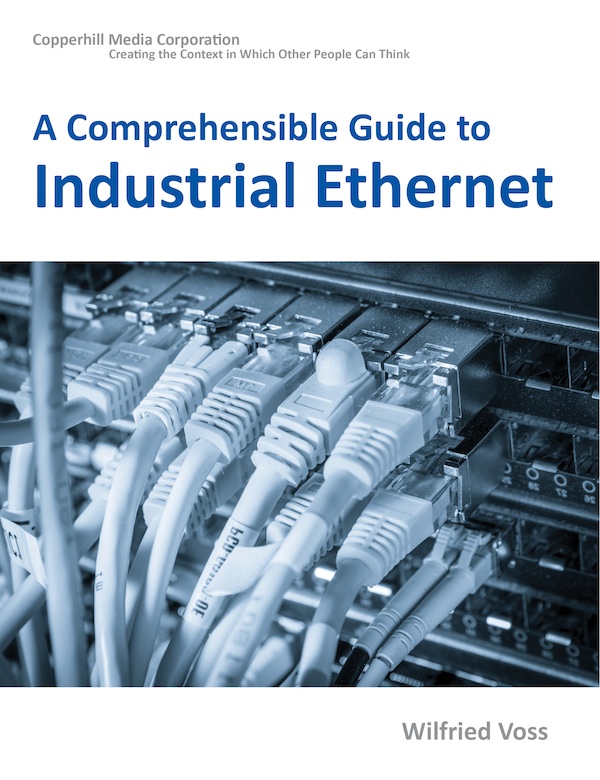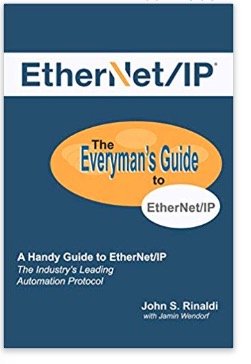Recent Posts
Industrial Ethernet Guide - The Motivation For Industrial Ethernet
Posted by on

The following is part of A Comprehensible Guide to Industrial Ethernet by Wilfried Voss.
The primary motivation for using Industrial Ethernet technologies can be described with only one word: Speed.
The Ethernet TCP/IP communication according to IEEE 802.3 supports 100 Mbit/sec over distances of 100 meters (~300 feet) between two devices (100BaseTx) or up to 2,000 meters (~6,000 feet), respectively (100BaseFx). No other standard networking technology provides this compelling combination of speed and physical network length, and the newer IEEE 802.3-2008 standard even defines a data transfer speed of 1 Gbit/sec.
Note: Some Industrial Ethernet protocols (e.g. EtherCAT, Sercos III) currently support only 100 Mbit/sec, while other technologies (e.g. Ethernet/IP, Modbus/TCP, Ethernet Powerlink) can be operated at 100 Mbit/sec and 1 Gbit/sec.
Along with the increased bandwidth and tight synchronization, Industrial Ethernet gives manufacturers the security of using a physical and data-link layer technology that has been standardized by both the IEEE and the ISO.
Furthermore, all of the various Industrial Ethernet protocols can support TCP/IP stacks so that Ethernet can easily gate to the Internet. This feature is attractive to manufacturers since it allows remote diagnostics, control, and observation of their plant network.
In general, the increased performance Industrial Ethernet protocols and their devices, compared to older technologies, break with many of the traditional views of the automation process.
Further arguments pro Industrial Ethernet are:
- Real-Time support with extremely low cycle times that were not feasible with other fieldbus systems
- Use of Standard Ethernet Cables, Connectors, Switches, and Hubs
- Increased Bandwidth with Larger Data Packages
- Increased Number of Connected Devices
- Increased Physical Network Length
- Use of Standard Monitoring and Diagnostic Tools
- Homogenous Networking throughout the manufacturing facility, from office to plant floor, addressing the needs for engineers in automation and control as well as in information technology.
While the data transfer speed is the significant technological advantage, Industrial Ethernet adds more value by continuing support for the Ethernet (IEEE 802.3) physical and data layers and TCP/IP/UDP, hence providing an interface to standard information-level networks and meeting the demands for the Ethernet technology plant of the future.
Note: The earliest versions of Industrial Ethernet, namely Modbus/TCP and Ethernet/IP, were developed and introduced with a primary focus on networking the manufacturing facility.
In addition, Industrial Ethernet technologies offer the same advantages as any other Fieldbus system.
EtherNet/IP: The Everyman’s Guide to The Most Widely Used Manufacturing Protocol
EtherNet/IP came roaring into the 21st century on the backs of DeviceNet and ControlNet, claiming world domination (almost) as the most widely used protocol in manufacturing.
While it’s pervasive, EtherNet/IP isn’t necessarily standard knowledge to everyone on the factory floor. Admit it; maybe you find yourself losing sleep over questions such as
- Is EtherNet/IP an IoT transport protocol?
- Are EDS files important for an EtherNet/IP adapter device?
- Which is better: EtherNet/IP or PROFINET IO?
- Isn’t EtherNet/IP just CIP over an Ethernet connection?
- How many ways are there to organize device data into a CIP Object Model?
- What is the Assembly Object Class?
- Can the EtherNet/IP encapsulation to encapsulate other automation protocols?
- Does it matter which TCP/IP stack we use to build an EtherNet/IP device?
- Is DeviceNet obsolete or complementary to EtherNet/IP? How important is the compliance test process?
- Is CoCO good for an EtherNet/IP scanner device, or delicious with marshmallows?
Toss and turn no more! With this handy guide on your bedside table, you’ll be able to navigate the world of EtherNet/IP and, who knows, maybe entertain a companion with exciting tidbits. Dip into any chapter, in any order, and you’ll find plenty of clear explanations, with tables and diagrams, to guide you through EtherNet/IP.
 Loading... Please wait...
Loading... Please wait...

